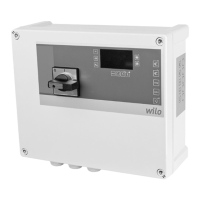InstallationandoperatinginstructionsWilo-ControlMS-L2x4kW 33
INSTALLATION English
4. Fixtheswitchgearusingfourscrews(max.Ø:
4mm)andappropriateanchorsontothewall.
5.3.3. Positioning of signal transmitters
For automatic control of the connected pump,
acorrespondinglevelcontroldevicemustbe
installed. This needs to be provided by the cus-
tomer.
Float switches may be used as signal transmitters.
Connection of level sensors or electrodes is not
possible!Thecorrespondingsignaltransmitters
must be installed according to the unit's installa-
tion plan.
DANGER - explosive atmosphere!
If the connected signal transmitters are used
in potentially explosive areas, there is adan-
ger of fatal injuries from explosions! Thecon-
nected signal transmitters must always be
used outside of potentially explosive areas.
Installation must always be carried out by
aqualied electrician.
Notethefollowing:
• Whenusingoatswitches,ensurethatthesecan
move freely in the operating space (pump cham-
ber, reservoir).
• The water level of the connected pump must not
fall below the minimum.
• Themaximumswitchingfrequencyofthecon-
nectedpumpmustnotbeexceeded.
5.4. Electrical connection
POTENTIALLY fatal danger due to electrical
voltage!
Incorrect electrical connections can cause fa-
tal electric shocks. Electrical connections may
only be carried out by aqualied electrician
approved by the local energy supply company,
in accordance with locally applicable regula-
tions.
DANGER - explosive atmosphere!
If the connected pump and signal transmitter
are used in potentially explosive areas, there
is adanger of fatal injuries from explosions!
Theconnected pump and signal transmitter
must always be used outside of potentially
explosive areas. Installation must always be
carried out by aqualied electrician.
NOTE
• Depending on the system's impedance and the
connectedconsumers'max.no.ofconnections/
hour,voltageuctuationsorvoltagedropsmay
occur. Always have the electrical connections
carried out by an electrician authorised by the
local energy supply company.
• Observe the installation and operating in-
structions for the connected pump and signal
transmitters.
• The mains connection current and voltage must
be as stated on the rating plate.
• All-pole disconnecting, K-type circuit breakers
must be installed!
• Max.fuseprotectiononmainsside:25A(16Afor
S version with shock-proof/CEE16 plug)
• Onswitchgearswithoutapowersupplysepa-
rationdevice(Oversion:withoutmainswitchor
plug) this must be provided by the customer!
• Itisrecommendedaresidual-current-operated
protection switch (RCD, type A, sinus wave-form
current) be installed. Observe the local laws and
regulations on this too!
• Route the power supply cable in accordance with
the valid norms and regulations and according to
the wiring diagram.
• Ground the system (switchgear and all electric
consumers) in accordance with the regulations.
Fig. 2.: Overview of individual components
A Switchgear with main switch
W Switchgear with plug
C Switchgear without main switch and plug
1 Main switch 6 DIP switch 2
2 Motor contactor 7
Potentiometer for fol-
low-up time
3 Terminal strip 8
Rechargeable battery
installation location
4 Earth terminals 9 Mains terminal strip
5 DIP switch 1
5.4.1. DIP switch
The switchgear has two DIP switches. These are
usedtoswitchvariousfunctionson/off:
• DIP switch 1, above the potentiometer
This DIP switch is used to adjust the rated current
for motor protection as well as activating or deac-
tivating the pump kick function and the internal
buzzer.
• DIP switch 2, under the potentiometer
This DIP switch is used to select the mains voltage
(standardversionand"O"versiononly),tostipu-
late the service intervals. activate/deactivate the
connected pumps and to monitor the operating
parameters (S version only).
5.4.2. Switchgear mains connection - with main
switch
Insert the cable ends of the power supply cable
laid on-site through the threaded cable connec-
tions and secure them accordingly.
Connect the wires to the main switchasfollows:
• Mainsconnection1~230V:
• Cable:3-core
• Terminals:4/T2(L),N(N)
• The protective earth conductor (PE) is connect-
ed to the earth terminal (;).
• DIPswitch2:DIPposition"1":OFF(bottom
position)

